Error processing SSI file
|
A Different Kind of Material Culture
By Kelly Gleason, NOAA
I am a maritime archaeologist working for the Papahanaumokuakea Marine National Monument. At first I thought I might be a little bit of an odd fit with the mission of this cruise. I’m accustomed to spending my time at sea diving off of small boats and documenting the shipwrecks, sunken aircraft and artifacts on the seafloor. The material remains I encounter during my work remind me of all of the seafaring history in the waters of the Pacific. I am able to study man’s relationship with the sea in a unique way.
 |
| Kelly Gleason (center), along with the crew, scans the ocean horizon for marine debris. |
For this mission on the NOAA ship Oscar Elton Sette, I have been a member of the “big eye team” and spend most of my time scanning the horizon for marine debris and marine mammals looking through large binoculars mounted to the deck of the ship.
At first working with the big eyes and surveying for debris seemed like a really far cry from my field of expertise. I have realized, however, that there is a certain irony to what I am doing. I am examining a different aspect of man’s relationship to the sea. Rather than shipwreck sites filled with history, I am witnessing the fishing gear, plastic bottles and styrofoam that drift by the ship. These things are the material remains that our generation has cast out into the ocean, and unfortunately, not necessarily by accident. Instead, the marine debris is often painfully preventable, and a problem we are all intimately linked to.
The work that I am doing on this cruise to spot marine debris is a different kind of survey of material culture (the objects mankind leaves behind). Shipwrecks remind us that seafarers must respect and understand the ocean environment. I think that there is a similar lesson with marine debris: it reminds us of how fragile the ocean environment can be, and as human beings we need to respect and care for its health.
I find myself wondering if the kind of damage we see with the marine debris is ever going to be reversible. Unlike the shipwrecks that have long ago claimed property and often lives, there is hope to change the course of our generations legacy of marine debris. Efforts such as the one I am part of on the NOAA ship Oscar Elton Sette provide hope that innovation, technology and outreach can help us to comprehend the problem, and change lifestyles.
I am excited to see the project unfold over the next two weeks and am hopeful that it will send a message that opens eyes to the way that we can affect our legacy to the ocean.
|



